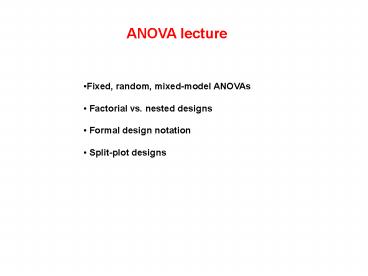Fixed, random, mixedmodel ANOVAs - PowerPoint PPT Presentation
Title:
Fixed, random, mixedmodel ANOVAs
Description:
Fixed, random, mixed-model ANOVAs. Factorial vs. nested designs. Formal ... Describe your ANOVA design to a statistician (who can then help you analyse it) ... – PowerPoint PPT presentation
Number of Views:63
Avg rating:3.0/5.0
Title: Fixed, random, mixedmodel ANOVAs
1
ANOVA lecture
- Fixed, random, mixed-model ANOVAs
- Factorial vs. nested designs
- Formal design notation
- Split-plot designs
2
- Goals
- Describe your ANOVA design to a statistician (who
can then help you analyse it). - Recognize three common types of ANOVA designs
- Factorial fixed, randomized block
- Nested
- Split-plot
- 3. For your reference formulas for F tests for
each
3
Factor a variable of interest e.g.
temperature Level a particular value / state
of a factor e.g. hot, cold In this example,
temperature is a factor with two levels.
4
Fixed factor Either (1) The investigator
chooses the levels of the factor for some
purpose. Eg. Ambient CO2 vs. double CO2 OR
(2) The levels used represent all possible
levels. Eg. Biological sex Male, female
5
Random factor The levels of the factor are
chosen randomly from a universe of possible
levels. Eg. We want to look at whether butterfly
collectors differ in their diversity estimates
for 4 plots. We select 5 collectors randomly
from a village. Eg. We use three breeding lines
of fruit flies as blocks in a genetics
experiment. Blocks are typically random effects!
6
Formal notation Af6 is a fixed factor called A
with 6 levels Br5 is a random factor called B
with 5 levels
7
- Group exercise (groups of 3)
- Experimental design handout
- Write out the factors and levels using formal
notation
8
ANOVA Example formal notation
Example 1 Ecologists Er10 Papers Pf2 Example
2 Populations Pr2 Herbivory Hf2 Example
3 Light Lf3 Nutrients Nf3 Blocks Br3
9
- Fixed-effects ANOVA (Model I)
- All factors are fixed
- Random-effects ANOVA (Model II)
- All factors are random
- Mixed-model ANOVA (Model III)
- Contains both fixed and random effects, e.g.
randomized block!
10
Two-way factorial ANOVA How to calculate F
Fixed effect (factors A B fixed)
Random effect (factors A B random)
Mixed model (A fixed, B random)
Factor A
MS A MS Error
MS A MS A x B
MS A MS A x B
Factor B
MS B MS A x B
MS B MS Error
MS B MS Error
A x B
MS A x B MS Error
MS A x B MS Error
MS A x B MS Error
11
Factorial design All levels of one factor
crossed by all levels of another factor, i.e. all
possible combinations are represented. If you
can fill in a table with unique replicates, its
factorial!
Double CO2
Ambient CO2
Pea plant
Bean plant
Corn plant
12
Nested design In this example, strain type is
nested within fertilizer. Fertilizer is often
called group, strain subgroup The nested
factor is always random
13
Fertilizer
O
N
P
Strain A
Strain B
Strain C
Strain D
Strain E
Strain F
14
Grand mean
Variance Group
No fertilizer Nitrogen
fertilizer Phosphorus fertilizer
Strain A Strain B Strain C
Strain D Strain E Strain F
15
Grand mean
Variance Group
No fertilizer Nitrogen
fertilizer Phosphorus fertilizer
Variance Subgroup within a group
Strain A Strain B Strain C
Strain D Strain E Strain F
16
Grand mean
Variance Group
No fertilizer Nitrogen
fertilizer Phosphorus fertilizer
Variance Subgroup within a group
Strain A Strain B Strain C
Strain D Strain E Strain F
Variance Among all subgroups
17
Nested ANOVA A Subgroups nested within B
Groups, with n replicates In our example, A2,
B3 and n2
df F
Groups
MS Groups MS Subgroups within groups
B-1
Subgroups within groups
B(A-1)
MS Subgroups within groups MS Among all subgroups
Among all subgroups
AB(n-1)
Total
ABn-1
18
Formal notation cont. Af6 x Br5 tells us that
this is a factorial design with factor A
crossed with factor B Af6 (Br5) tells us that
this is a nested design with factor A nested
within with factor B. In other words, A is
subgroup, B is group.
19
- Group exercise (groups of 3)
- Experimental design handout
- Write out the factors and levels using formal
notation
20
Example 1 Er10 x Pf2 Example 2 Pr2
(Hf2) Example 3 Br3 x Lf3 x Nf3
21
Split plot design An experiment replicated
within an experiment!
4 Main plots, e.g. greenhouses
Elevated CO2
Ambient CO2
22
Split plot design An experiment replicated
within an experiment!
23
Split plot design An experiment replicated
within an experiment!
4 Main plots, e.g. greenhouses
Elevated CO2
Ambient CO2
24
Split plot design An experiment replicated
within an experiment!
3 5 6 2 4 1
6 3 2 5 1 4
5 3 6 4 2 1
1 5 6 3 2 4
Subplots with six different nutrient
concentrations
25
Split plot design An experiment replicated
within an experiment!
Subplot nutrient MS subtreat F nutrient x
CO2 MS subinteract F Subplot error MS suberror
26
Split plot design An experiment replicated
within an experiment!
Main plot CO2 MS maintreat F Main plot
error MS mainerror
Subplot nutrient MS subtreat F nutrient x
CO2 MS subinteract F Subplot error MS suberror

